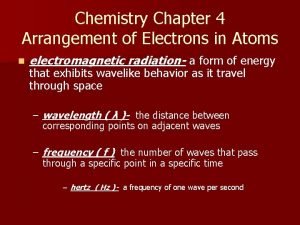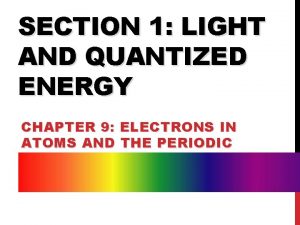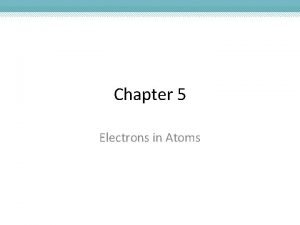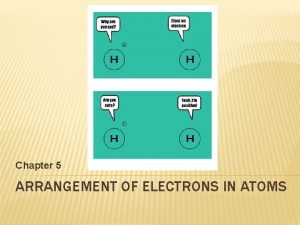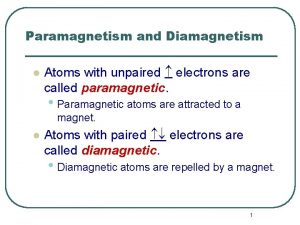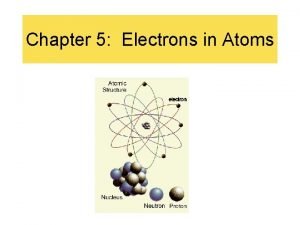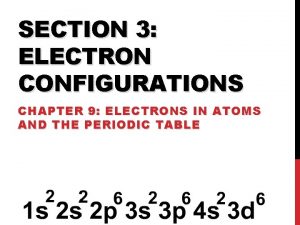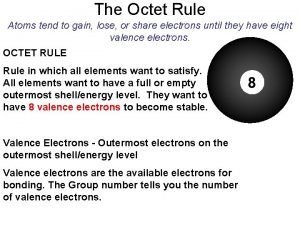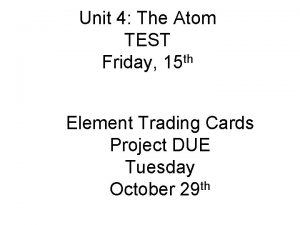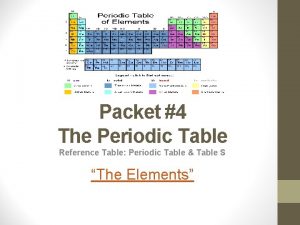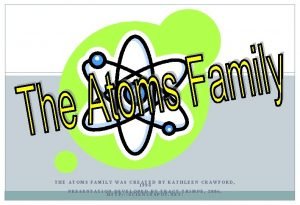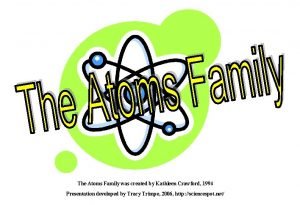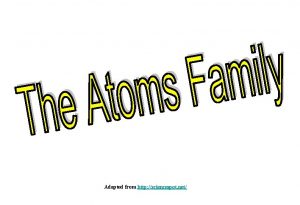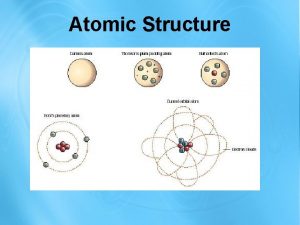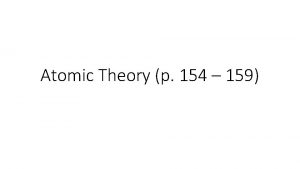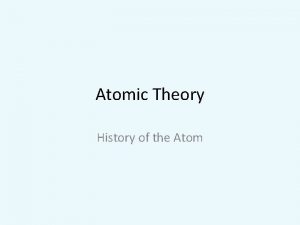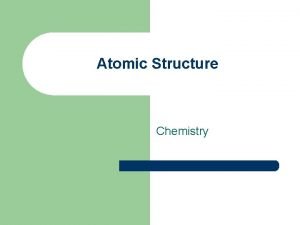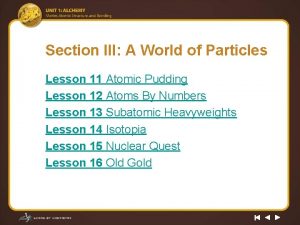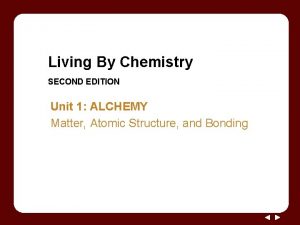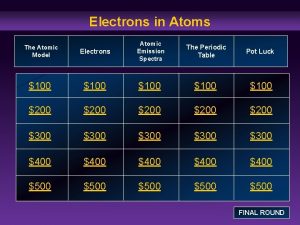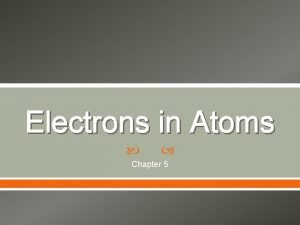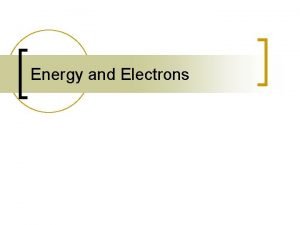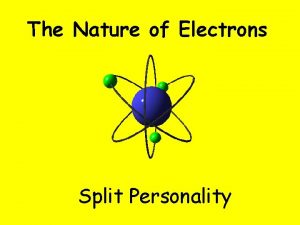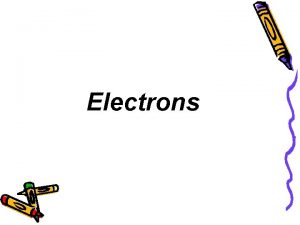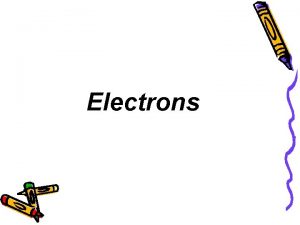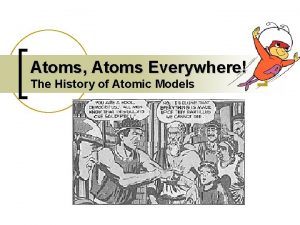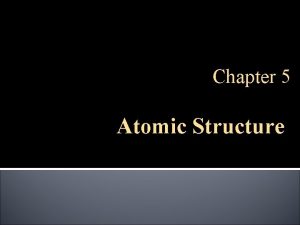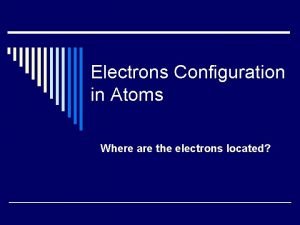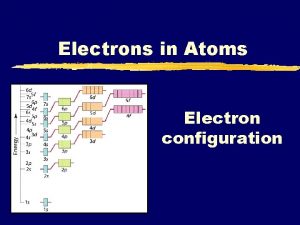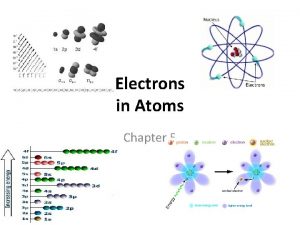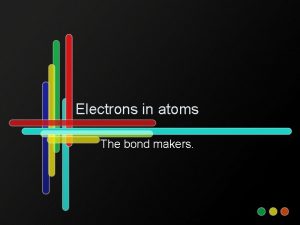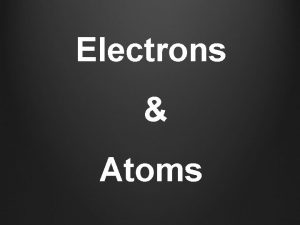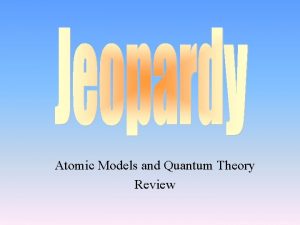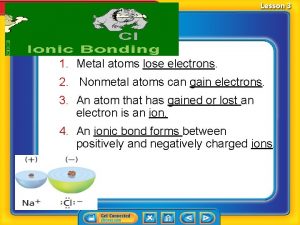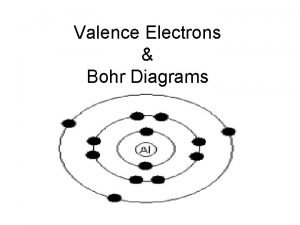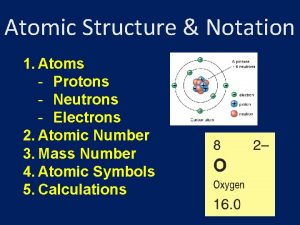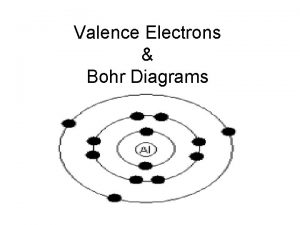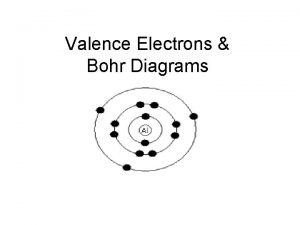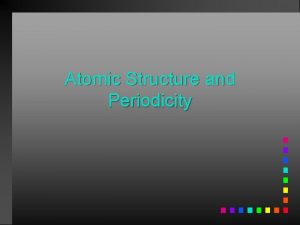Electrons in Atoms Evolution of Atomic Models For







































- Slides: 39

Electrons in Atoms

Evolution of Atomic Models • For about 50 years after Dalton, the atom was considered a solid indivisible mass • JJ Thomson proposed the plumpudding model

Evolution of Atomic Mdels • Rutherford proposed the nuclear atom, with a dense nucleus • Niels Bohr propsed that electrons move in orbits around the nucleus

Evolution of Atomic Models • Bohr proposed that electrons have a fixed energy • The energy level of an electron is the region where the electron is likely moving • Energy levels are like stairs. To move to the next stair you have to move the correct amount, or you won’t move

Evolution of Atomic Models • A quantum of energy is the amount of energy required to move an electron to the next higher energy level • In general, the higher the energy level of the electron, the farther it is from the nucleus

Quantum Mechanical Model • Schrodinger’s equation describes the location and energy of electrons quantum mechancial model • Estimates the probability of finding an electron in a certain position

Quantum Mechanical Model • In this model, the probability of finding an electron is represented by a fuzzy cloud • The cloud is more dense where the probability of finding electrons is high and less dense where the probability of finding electrons is low

Atomic Orbitals • The Q-M Model designates energy levels with principal quantum numbers (n) • They are assigned in order of increasing energy (greater distance from nucleus) • n – 1, 2, 3, 4, …. .

Atomic Orbitals • Within each energy level, there are sublevels • The number of energy sublevels is the same as the principal quantum number • Describes the SHAPE of the orbital • s, p, d, f

Atomic Orbitals • Within each sublevel, there are regions where electrons are likely to be found, called atomic orbitals • Atomic orbitals are denoted by letters • s is spherical in shape, p is dumbbellshaped, d is cloverleaf-shaped, and f is a complex shape pg 103 in book

Atomic Orbitals • The numbers and kinds of atomic orbitals depend on the energy sublevel • n = 1: 1 sublevel – 1 s (1 orbital, s) • n = 2: 2 sublevels – 2 s, 2 p (4 orbitals, s and 3 p) • n = 3: 3 sublevels – 3 s, 3 p, 3 d (9 orbitals, s, 3 p, and 5 d) • n = 4: 4 sublevels – 4 s, 4 p, 4 d, 4 f (16 orbitals, s, 3 p, 5 d, and 7 f)

Atomic Orbitals • There a maximum of two electrons per orbital • Each sublevel also has a maximum number of orbitals Sublevel Max # of orbitals Max # of electrons s 1 2 p 3 6 d 5 10 f 7 14

Atomic Orbitals • Because of the maximum allowed electrons per orbital, and the maximum orbitals per type of orbitals, it can be determined how many electrons are allowed in each energy level Energy level n 1 2 3 4 Max # of electrons 2 (s) 6 (s, p) 18 (s, p, d) 32 (s, p, d, f)

Development of the New Atomic Model

Light and Atomic Spectra • Isaac Newton proposed that light was made of particles • By 1900, most scientists had accepted that light was a wave

Light and Atomic Spectra • According to the wave model, light consists of electromagnetic waves • Electromagnetic radiation includes radio waves, microwaves, infrared waves, visible light, ultraviolet waves, x-rays, and gamma rays

Light and Atomic Spectra • Four properties for measuring waves: • Amplitude – wave’s height from the origin to the crest • Wavelength (λ) – distance between crests

Light and Atomic Spectra • Frequency (ν) – the number of wave cycles to pass a given point per unit time • The units of frequency are cycles per second. The SI unit is the Hertz (Hz) which can also be expressed as s-1 • Speed (c) – the rate at which the wave travels

What do you think the relationship is between speed (c), frequency (ν), wavelength (λ)?

Light and Atomic Spectra • There is a relationship between the speed, frequency, and wavelength of light • c = λν • c is constant that equals 3. 0 x 108 m/s

Light and Atomic Spectra • When light passes through a prism, it produces a spectrum of colors. • ROYGBIV (red-orange-yellow-green-blueindigo-violet) is the range of visible light (380 nm – 700 nm)

Light and Atomic Spectra • Every element emits light when it is excited by the passage of an electric discharge through its gas or favor • Passing this light through a prism results in the atomic emission spectrum of the element

Quantum Concept • Classical physics does not explain the line spectra of the elements • Max Planck attempted to describe why iron changes color as it is heated

Quantum Concept • Planck showed that the amount of radiant energy (E) absorbed or emitted is proportional to the frequency of the radiation. • E = hν (Planck’s constant, h = 6. 626 x 10 -34 Js)

Quantum Concept • The energy absorbed or emitted is a quantum • Quanta are so small, that you are unaware that energy is quantized


Photoelectric Effect • Albert Einstein proposed that light could be described as quanta of energy that behave like particles, called photons • This led to theory of the dual nature of light

Photoelectric Effect • In the photoelectric effect metals eject electrons when light shines on them • It depends on the frequency of the light , contrary to the ideas of classical physics

Atomic Spectra • Bohr’s application of quantum theory to electron energy levels in atoms resulted in an explanation of the hydrogen spectrum

Atomic Spectra • When an electron is in the lowest energy level it is in the ground state • When an electron is excited, it raised to higher energy level. As it comes back to ground state, energy is emitted in the form of light

Quantum Mechanics • Louis de Broglie proposed that matter could also have a dual nature • λ = (h/mν) (de Broglie’s equation) • Objects with measurable wavelengths cannot be seen by the unaided eye

Quantum Mechanics • Werner Heisenberg stated that it is impossible to know exactly both velocity and the position of a particle at the same time (Heisenberg Uncertainty Principle)

Electron Configurations • In atoms, electrons and the nucleus interact to make the most stable arrangement possible. • The ways in which electrons are arranged around the nucleus are called electron configurations.

Electron Configurations • Three rules tell you how to find electron configurations: • Aufbau Principle – Electrons enter orbitals of lowest energy first. (see diagram on page 367 of your book)

Electron Configurations • Pauli Exclusion Principle – An atomic orbital may have a maximum of two electrons. These electrons must have opposite spins (paired)

Electron Configurations • Hund’s Rule – When electrons occupy orbitals of equal energy, one electron enters each orbital until all the orbitals contain one electron with parallel spins

Electron Configurations • Electron configurations are written in the following way: • Carbon (6 electrons) – 1 s 22 p 2 • 1, 2 = energy level • s, p = sublevel • Superscript 2 = number of electrons in the sublevel • ** Note that the sum of the supersrcipts equals the number of electrons in the atom

Electron Configurations • Electron configurations can also be abbreviated by substituting for the electron configuration of the previous noble gas: • Carbon – 1 s 22 p 2 • Abbreviated – [He]2 s 22 p 2 • 1 s 2 is the electron configuration for He, so the symbol He replaced its electron configuration

Electron Configurations • There are some exceptions to the rules, such as copper and chromium
 At stp which substance is the best conductor of electricity
At stp which substance is the best conductor of electricity How to find the neutrons of an element
How to find the neutrons of an element Chapter 4 arrangement of electrons in atoms
Chapter 4 arrangement of electrons in atoms Electrons in atoms section 1 light and quantized energy
Electrons in atoms section 1 light and quantized energy How do chemists model the valence electrons of metal atoms?
How do chemists model the valence electrons of metal atoms? Electrons in atoms section 1 light and quantized energy
Electrons in atoms section 1 light and quantized energy Chapter 5 electrons in atoms
Chapter 5 electrons in atoms Atoms with 4 valence electrons
Atoms with 4 valence electrons Ionic and metallic bonding chapter 7 practice problems
Ionic and metallic bonding chapter 7 practice problems Section 2 quantum theory and the atom
Section 2 quantum theory and the atom Chapter 5 review arrangement of electrons in atoms
Chapter 5 review arrangement of electrons in atoms Diamagnetic elements
Diamagnetic elements 5 electrons in atoms
5 electrons in atoms Electrons configurations
Electrons configurations Electrons in atoms section 2 quantum theory and the atom
Electrons in atoms section 2 quantum theory and the atom Octet rule
Octet rule The atoms family atomic math challenge answer key
The atoms family atomic math challenge answer key The atom family atomic math challenge
The atom family atomic math challenge Reference table periodic table
Reference table periodic table Matterville answer key
Matterville answer key The atoms family atomic math challenge
The atoms family atomic math challenge Http sciencespot net
Http sciencespot net Periodic trends in periodic table
Periodic trends in periodic table Atomic number vs atomic radius
Atomic number vs atomic radius What is atomic radius
What is atomic radius How to calculate abundance of isotopes
How to calculate abundance of isotopes Relative atomic mass of beryllium
Relative atomic mass of beryllium Differentiate between atomic number and mass number
Differentiate between atomic number and mass number Atomic model evolution
Atomic model evolution Atomic models in order
Atomic models in order How many protons does oxygen have
How many protons does oxygen have Plum pudding model
Plum pudding model Lesson 11 atomic pudding models of the atom
Lesson 11 atomic pudding models of the atom Atom model timeline
Atom model timeline Atomic alchemy
Atomic alchemy Difference between modal and semi modal
Difference between modal and semi modal Texter för hinduer tantra
Texter för hinduer tantra Jätte råtta
Jätte råtta Verktyg för automatisering av utbetalningar
Verktyg för automatisering av utbetalningar Expektans
Expektans


